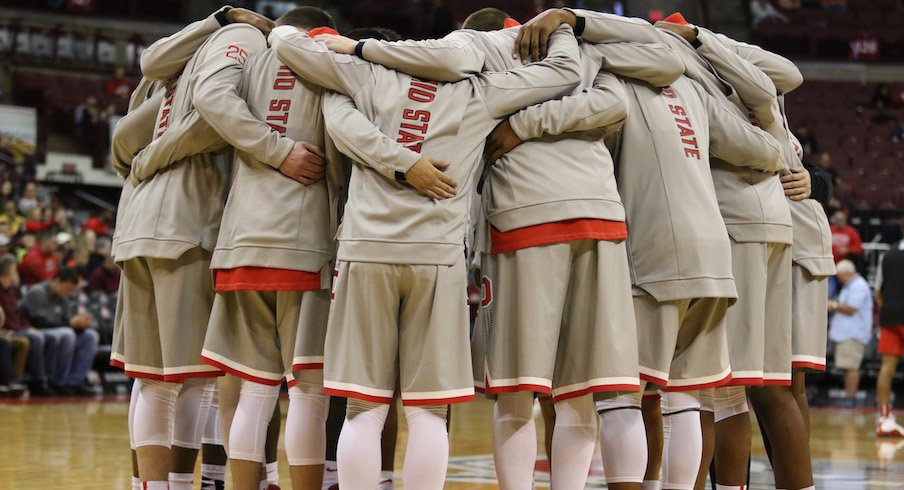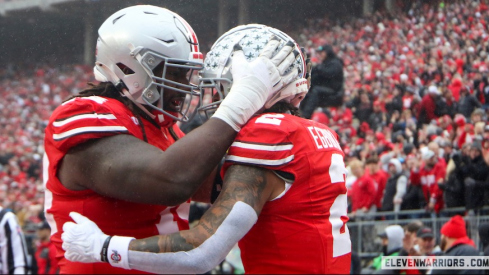The Ohio State men's basketball team is better this season than it was last season.
A stunning revelation, I know.
Anyone with eyes could see this basketball team is drastically better than its 2016-17 counterpart, and it's been reflected in the win column.
It's been one of the most drastic single-season swings in Buckeye basketball history, especially given that both teams were comprised of many of the same primary contributors.
We wanted to know how this drastic change happened and where this improvement came from, so we dug a little deeper.
Here's a statistical comparison of last season's Buckeye team that failed to even earn an NIT bid to the one that's in the drivers seat in the Big Ten Conference with just four games to play.
Team Totals
| Season | FG% | 3P% | FT% | O-RB | D-RB | T-RB | AST | STL | BLK | TOV | PTS |
|---|---|---|---|---|---|---|---|---|---|---|---|
| 2016-17 | .463 | .356 | .682 | 10.1 | 27.1 | 37.2 | 13.6 | 5.2 | 3.8 | 13.2 | 72.8 |
| 2017-18 | .488 | .354 | .741 | 9.4 | 27.5 | 37.0 | 14.9 | 6.0 | 3.7 | 12.0 | 76.9 |
| Difference | + .025 | – .002 | + .059 | – 0.7 | + 0.4 | – 0.2 | + 1.3 | + 0.8 | – 0.1 | – 1.2 | + 4.1 |
Despite what you see on the court and what's been reflected in the win column, Ohio State has not actually been drastically better on the offensive end this season.
The Buckeyes are averaging just four more points per game, are shooting just slightly better from the field and the free-throw line, and are actually shooting slightly worse from three-point range.
The offense has definitely been better – it just hasn't been seven wins better. That's where we turn to the defense.
| Season | FG% | 3P% | FOULED | O-RB | D-RB | T-RB | AST | TOV | PTS |
|---|---|---|---|---|---|---|---|---|---|
| 2016-17 | .416 | .356 | 17.6 | 11.0 | 24 | 35.0 | 13.0 | 12.1 | 69.8 |
| 2017-18 | .410 | .341 | 17.1 | 8.6 | 22.4 | 31.0 | 11.7 | 12.8 | 66.1 |
| Difference | – .006 | – .015 | – 0.5 | – 2.4 | – 1.6 | – 4.0 | – 1.3 | + 0.9 | – 3.7 |
Defensively, Ohio State has been better across the board, even if only slightly.
So far this season, the Buckeyes have held the opponents to a lower field goal percentage and three-point shooting percentage, fouled opponents fewer times, done a better job of controlling the glass and forced more turnovers.
All of that has led to a 3.7 point per game decrease in opponents scoring.
Combine that with the extra 4.1 points per game the offense is scoring, and Ohio State is roughly 7.8 points per game better this season than last – which is fairly significant considering the Buckeyes lost eight of their 15 games last season by less than that margin.
The players have improved individually, too, especially where the team has needed that improvement most. Let's look at the returning players' numbers from this season compared to last.
C.J. Jackson
| Season | FG% | 3P% | FT% | O-RB | D-RB | T-RB | AST | STL | BLK | TOV | PTS |
|---|---|---|---|---|---|---|---|---|---|---|---|
| 2016-17 | .395 | .321 | .673 | 0.4 | 2.1 | 2.5 | 2.9 | 0.8 | 0.0 | 1.3 | 5.6 |
| 2017-18 | .410 | .376 | .817 | 0.5 | 3.5 | 4.0 | 4.2 | 1.0 | 0.2 | 2.4 | 12.5 |
| Difference | + .015 | + .055 | + .144 | + 0.1 | + 1.4 | + 1.5 | + 1.3 | + 0.2 | + 0.2 | + 1.1 | + 6.9 |
C.J. Jackson might be the most improved player on Ohio State's roster.
Much of the increase in production is due to increased minutes, as he has played over 10 more minutes per game this season than last, but Jackson improved in nearly every statistical category since last season.
The now-starting point guard has become more a more efficient scorer, a better three-point shooter, better from the free-throw line and scores twice as many points per game.
The one area Jackson has regressed is in turnovers per game, but when you account for the extra minutes he's played this season, it's not a drastic difference.
Given he's the primary ball-handler on the team lacking backcourt depth, Jackson's improvement has been absolutely vital to Ohio State's success.
Keita Bates-Diop
| Season | FG% | 3P% | FT% | O-RB | D-RB | T-RB | AST | STL | BLK | TOV | PTS |
|---|---|---|---|---|---|---|---|---|---|---|---|
| 2015-16* | .453 | .324 | .787 | 1.4 | 4.9 | 6.4 | 1.1 | 0.7 | 1.2 | 1.4 | 11.8 |
| 2017-18 | .509 | .364 | .821 | 1.5 | 7.5 | 9.0 | 1.5 | 1.0 | 1.6 | 1.7 | 20.2 |
| Difference | + .056 | + .040 | + .034 | + 0.1 | + 2.6 | + 2.6 | + 0.4 | + 0.3 | + 0.4 | + 0.3 | + 8.4 |
*We used Bates-Diop's 2015-16 season due to his injury during the 2016-17 season
The only player who might have shown more improvement since his last full season – the 2015-16 season – than Jackson is current Big Ten Player of the Year frontrunner Keita Bates-Diop.
Bates-Diop, like Jackson, has improved in nearly every statistical category. But unlike Jackson, you can't attribute those improvements to increased minutes. Bates-Diop has played just one more minute per game this season than his second season in Columbus.
Of course, there's no real way of telling when his development happened, as Bates-Diop missed most of last season with an injury, but he is a drastically different player now than he was then.
Jae'Sean Tate
| Season | FG% | 3P% | FT% | O-RB | D-RB | T-RB | AST | STL | BLK | TOV | PTS |
|---|---|---|---|---|---|---|---|---|---|---|---|
| 2016-17 | .547 | .222 | .573 | 1.9 | 4.5 | 6.4 | 2.0 | 1.1 | 0.5 | 2.3 | 14.3 |
| 2017-18 | .548 | .231 | .616 | 1.1 | 4.8 | 5.9 | 2.9 | 1.1 | 0.6 | 2.3 | 12.7 |
| Difference | + .001 | + .009 | + .043 | – 0.8 | + 0.3 | – 0.5 | + 0.9 | 0 | + 0.1 | 0 | – 1.6 |
Statistically, Jae'Sean Tate is basically the same player he was last season, which is not a problem.
Last season, Tate was Ohio State's leading scorer, second-leading rebounder and go-to player. This season, Tate's rebounding and scoring has fallen off, but only slightly. Meanwhile, he's become a slightly more efficient scorer, a slightly better shooter from the free-throw line and three-point range, and a better passer.
Tate's rebounding and scoring numbers have decreased very slightly, but it's not because he's regressed – everyone else is just pulling more weight.
Kam Williams
| Season | FG% | 3P% | FT% | O-RB | D-RB | T-RB | AST | STL | BLK | TOV | PTS |
|---|---|---|---|---|---|---|---|---|---|---|---|
| 2016-17 | .391 | .376 | .919 | 0.3 | 1.8 | 2.1 | 1.0 | 0.8 | 0.1 | 1.1 | 9.4 |
| 2017-18 | .486 | .463 | .800 | 0.1 | 1.8 | 2.0 | 0.5 | 0.5 | 0.0 | 0.6 | 8.0 |
| Difference | + .095 | + .087 | – .119 | – 0.2 | 0 | – 0.1 | – 0.5 | – 0.3 | – 0.1 | – 0.5 | – 1.4 |
Kam Williams' numbers haven't changed drastically since last season – for better or for worse – except for his shooting numbers.
Williams has stepped into his role as a jump shooter this season, increasing both his field goal percentage and three-point shooting percentage significantly. It hasn't led to an increase in scoring as Williams has averaged 1.4 fewer points this season than last, though this is probably due to an increase in everyone else's offensive production.
The one area Williams appears to have regressed is free-throw shooting. Williams was the team's best free-throw shooter last season, shooting nearly 92 percent from the charity stripe. This year, though, Williams has shot just 80 percent from the line , which is especially surprising considering nearly everybody else is noticeably better from the line.
All-in-all though, Williams has gotten better in his area of expertise, which has benefitted the team.
Micah Potter
| Season | FG% | 3P% | FT% | O-RB | D-RB | T-RB | AST | STL | BLK | TOV | PTS |
|---|---|---|---|---|---|---|---|---|---|---|---|
| 2016-17 | .434 | .333 | .600 | 1.2 | 1.9 | 3.1 | 0.3 | 0.3 | 0.4 | 0.7 | 4.1 |
| 2017-18 | .507 | .286 | .762 | 1.1 | 1.4 | 2.5 | 0.5 | 0.1 | 0.4 | 0.4 | 4.1 |
| Difference | + .073 | – .027 | + .162 | – 0.1 | – 0.5 | – 0.6 | + 0.2 | – 0.2 | 0 | – 0.3 | 0 |
Like Williams, Micah Potter has not been a drastically different player statistically from last season to this season. The differences in his numbers are nearly negligible – especially given he averages four fewer minutes this season – aside from his field goal percentage and free-throw shooting percentage.
Potter has been a noticeably more efficient scorer this season, averaging 50.7 percent from the field compared to just 43.4 percent last season. He's also drastically improved his free-throw shooting, shooting 76.2 percent form the line this season compared to just 60 percent last season.
Ohio State hasn't needed huge minutes or production from him this year, but he's stepped up anyway in areas where he's struggled, and it's certainly been helpful to the Buckeyes.
Andre Wesson
| Season | FG% | 3P% | FT% | O-RB | D-RB | T-RB | AST | STL | BLK | TOV | PTS |
|---|---|---|---|---|---|---|---|---|---|---|---|
| 2016-17 | .365 | .351 | .536 | 0.5 | 0.7 | 1.2 | 0.3 | 0.2 | 0.2 | 0.6 | 2.3 |
| 2017-18 | .371 | .293 | .667 | 0.6 | 1.2 | 1.8 | 1.0 | 0.2 | 0.1 | 1.2 | 2.6 |
| Difference | + .006 | – .058 | + .131 | + 0.1 | + 0.5 | + 0.6 | + 0.7 | 0 | – 0.1 | + 0.6 | + 0.3 |
Andre Wesson has improved nearly across the board, but just slightly. He's been slightly better in scoring, rebounding, protecting the ball, though the increase in production is almost negligible when you account for the increased number of minutes.
The one area Wesson has grown is in free-throw shooting – a pretty consistent theme among returning players. Wesson shot just 53.6 percent from the line his freshman season. Now, that number is hovering much closer to 70 percent as he currently makes every third free throw.
These numbers don't tell all of Wesson's story, though, as he's emerged as one of the team's better defenders and has no doubt benefitted the team in ways that is impossible to quantify.


